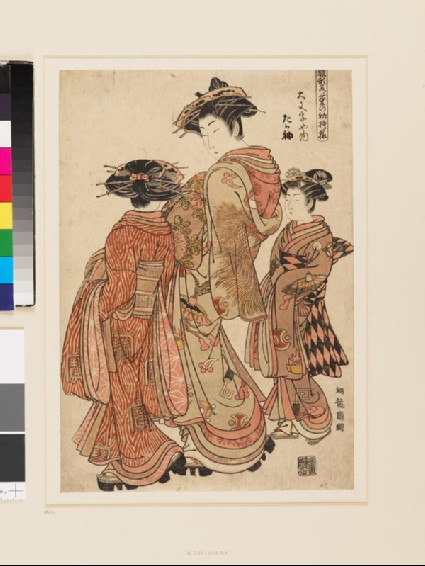Browse: 1244 objects
The Courtesan Tagasode of Daimonji-ya
-
Details
- Series
- Fashion Patterns: First Designs of Young Leaves
- Associated place
- Date
- 1778
- Artist/maker
-
Isoda Koryūsai (1735 - 1790) (designer)
- Associated people
-
Nishimuraya Yohachi (c. 1751 - c. 1870) (publisher)Tagasode of Daimonji-ya (probably active late 18th century) (subject)
- Material and technique
- nishiki-e (multi-block) woodblock print, printed with water-based vegetable pigments
- Dimensions
-
mount 55.7 x 40.6 cm (height x width)
print 35.1 x 24.5 cm (height x width)
- Material index
- Technique index
- Object type index
- No. of items
- 1
- Credit line
- Presented by Mrs Allan and Mr and Mrs H. N. Spalding, 1952.
- Accession no.
- EAX.4042
-
Further reading
Oxford: Ashmolean Museum, 24 August-30 November 2005, Beauties of the Four Seasons, Mitsuko Watanabe, ed. (Oxford: Ashmolean Museum, 2005), no. 4 on p. 8, pp. ix, xii-xiii, & 6, illus. pp. ix & 9
Glossary (2)
nishiki-e, vegetable pigments
-
nishiki-e
Nishiki-e literally means 'brocade pictures' and refers to multi-coloured woodblock prints.
-
vegetable pigments
Vegetable pigments were used to create coloured dyes for Japanese prints, paintings, and textiles. These pigments often faded over time due to the chemical reactions they underwent.
Location
-
- currently in research collection
Objects are sometimes moved to a different location. Our object location data is usually updated on a monthly basis. Contact the Jameel Study Centre if you are planning to visit the museum to see a particular object on display, or would like to arrange an appointment to see an object in our reserve collections.
Publications online
-

Beauties of the Four Seasons
This series was issued over several years from around 1772, and was the most popular series produced by Koryūsai. The oiran (the highest rank of the courtesans) Tagasode of Daimonji-ya is depicted wearing a kimono with the latest designs and is standing between her two kamuro who are also wearing new fashions of kimono and obi (sash). This print is one of the designs of spring from the series of Hinagata wakana no hatsumoyō, which consists of more than a hundred prints. The illustrations were especially for the courtesans of Yoshiwara during the New Year.
The designs of her kimono, obi, ornamental combs and hairpins are beautifully depicted and Tagasode herself is consciously posing in order to introduce some new patterns, reminding us of the fashion models of today. The design of the kimono worn by the oiran and the kamuro (lowest rank) on the left are in pink and purple kimono. The design on the outer garment of both the oiran and the kamuro on her right hand side is called takara-zukushi, which is a symbol of good fortune. -

Beauties of the Four Seasons
This series was issued over several years from around 1772, and was the most popular series produced by Koryūsai. The oiran (the highest rank of the courtesans) Tagasode of Daimonji-ya is depicted wearing a kimono with the latest designs and is standing between her two kamuro who are also wearing new fashions of kimono and obi (sash). This print is one of the designs of spring from the series of Hinagata wakana no hatsumoyō, which consists of more than a hundred prints. The illustrations were especially for the courtesans of Yoshiwara during the New Year.
The designs of her kimono, obi, ornamental combs and hairpins are beautifully depicted and Tagasode herself is consciously posing in order to introduce some new patterns, reminding us of the fashion models of today. The design of the kimono worn by the oiran and the kamuro (lowest rank) on the left are in pink and purple kimono. The design on the outer garment of both the oiran and the kamuro on her right hand side is called takara-zukushi, which is a symbol of good fortune.
© 2013 University of Oxford - Ashmolean Museum

